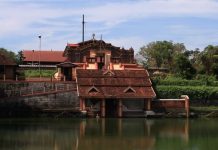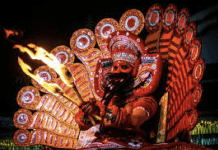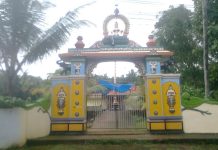Sri Sanjeevi Rayan Temple is a Hindu temple located in Iyengar Kulam, a small village in the Kanchipuram district of Tamil Nadu, India. The temple is dedicated to Lord Hanuman, who is also known as Sanjeevi Rayan.
Legends
According to one of the legends, the temple is associated with the famous epic, Ramayana. It is said that when Hanuman was carrying the Sanjeevi hill to revive Lakshmana during the battle between Rama and Ravana, a piece of the Sanjeevi mount fell at this spot. Following this legendary story, the place is considered sanctified, and even today, the people of Iyengar Kulam believe that no one dies of any kind of poisoning or snake-bite here.
In another legend, Thatha Desikan and his disciples were traveling with wealth to offer to Sri Varadharaja Perumal of Kanchipuram. When they reached this spot, they decided to stay there for the night. During the night, some thieves stole all the wealth, but a group of monkeys came and chased them away, guarding the wealth. Thatha Desikan believed that the head monkey was none other than Hanuman, and as a token of gratitude, he built the Sri Sanjeevi Rayan Temple and composed a poem in Sanskrit called “Srimad Hanumath Vimsathi”.
These legends add to the mystical aura of the temple and make it a place of great significance and devotion for the devotees.
History
The history of this temple complex and the contributions of Sri Lakshmi Kumara Thatha Desikan. He was a prominent minister and philanthropist during the Vijayanagara Dynasty, serving as a Rajaguru for the kings Venkatapathy Rayas-I and II. He was also known for his charitable work, conducting many marriages for the poor, which earned him the title of “Koti Kanniyadhana Lakshmi Kumara Thatha Desikan” or “Ettur Lakshmi Kumara Thathacharya.”
In addition to his philanthropic activities, Sri Thatha Desikan was also involved in the construction of the temple complex, which is a remarkable feat of architecture and engineering. He was responsible for excavating a large tank called “Thatha Samudram,” located on the northern side of the temple. He also oversaw the construction of two huge wells known as “Nadai-Vavi.”
Sri Thatha Desikan’s contributions to the temple complex and the surrounding areas demonstrate his commitment to improving the lives of the people around him. His legacy lives on today, as the temple complex remains a significant religious and cultural landmark in the region.
Architecture
The Sri Sanjeevi Rayar Temple, constructed in the 16th century AD, boasts the unique Vijayanagara architectural style with various exceptional features. Its temple complex comprises a sanctum sanctorum, artha mandapam, maha mandapam, and Mukha mandapam, including a Nagara style stucco 3 tier Vimana above the sanctum sanctorum. The principal sanctum facing north is uncommon, distinguishing the temple’s singularity, which solely enshrines a splendid six feet tall statue of Lord Anjaneya in the anjali hasta pose.
The maha-mandapa in front of the main shrine is fortified by fifty massive, embellished pillars, reflecting the remarkable skills of the Vijayanagar epoch’s architects. The temple complex encompasses three circumambulatory passages (prakaras), with the innermost and narrowest prakara surrounding the garbha-griha, while the outer two prakaras contain various ornate and majestic four-pillared mandapas, despite their current dilapidated condition.
Additionally, the temple boasts a vast sacred tank called Tatasamudram, encompassing 133 acres and enclosed by a high bund named Valkottai, where people suffering from various ailments come to inhale the pure air that devotees believe has healing powers due to its association with the Sanjeevi hill.
Apart from Lord Anjaneya, the temple houses idols of other deities, including Mahalakshmi, Lord Rama, Sita, Lakshmana, and a 6-feet-tall statue of Garuda with wings and a charming smile. The temple also houses a Thulasi Madam, a small shrine dedicated to the holy basil plant considered sacred in Hindu mythology.
The Moolavar, meaning the primary deity Sri Anjaneya, and Garuda, who carries Lord Vishnu, are carved on a stone slab in bas-relief form. The prakaram also contains a stone uruli or bowl and a massive stone slab, believed to have medicinal properties that people drink water from and touch to cure various diseases.
Overall, the Sri Sanjeevi Rayar Temple is a sacred place of worship for Hindus, attracting visitors worldwide to seek blessings from Sri Anjaneya and other deities. Its significant architectural style testifies to the contemporary artists’ exceptional craftsmanship and is a crucial religious and legendary site.


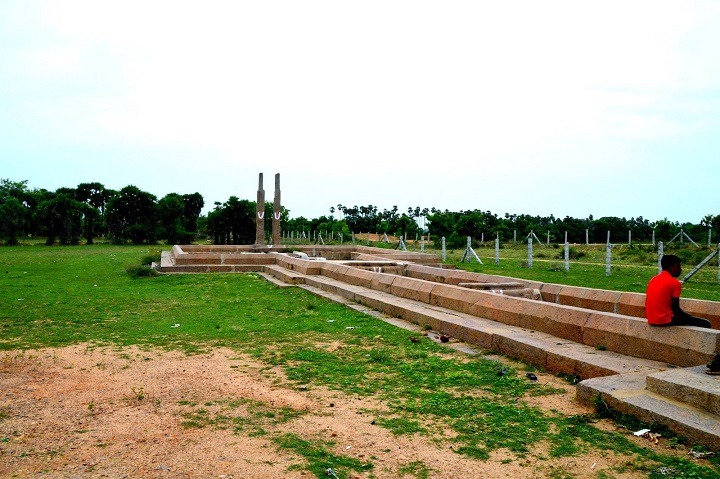

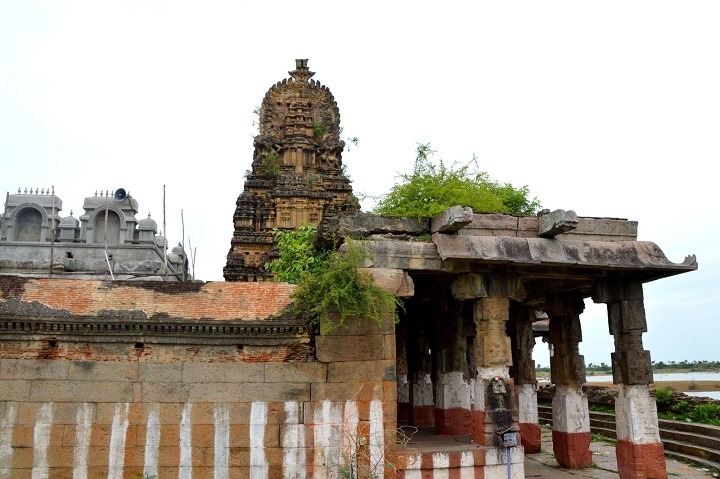
Festivals
The temple observes several festivals that showcase the cultural and religious significance of this traditional temple. It is considered a sanctified Prarthana Sthala, and the festivals testify to the religious importance of the temple. The temple follows the rules of Vaikhanasa Agama for offering worship to God. The most significant festival celebrated in the temple are
- Rama Navami: On this auspicious occasion, the Thirukalyanam (marriage ceremony) of Lord Rama and Sita is celebrated with great fervor and devotion.
- Hanuman Jayanthi: This festival is celebrated in honor of Lord Hanuman, who is considered as the epitome of devotion and strength. Special poojas and rituals are conducted on this day.
- Tamil Month Chitra Pournami Days: Chitra Pournami is the full moon day in the Tamil month of Chithirai. On this day, it is believed that Lord Varadaraja Perumal used to visit Iyengar kulam and stayed at Nadavavi. Special poojas and celebrations are held at the temple on this day.
Temple Timings
The temple is open from 07:00 AM to 10:00 AM in the morning and from 04:30 PM to 07:00 PM in the evening.
How to reach
To reach Sri Sanjeevi Rayan Temple in Iyengar Kulam, Kanchipuram, you can follow these directions:
By Air:
The nearest airport is Chennai International Airport, which is approximately 68 km away from Kanchipuram. From there, you can hire a taxi or take a bus to Kanchipuram.
By Train:
Kanchipuram has its own railway station, and trains from major cities like Chennai, Bangalore, and Hyderabad run regularly to Kanchipuram. From the railway station, you can hire a taxi or take a bus to the temple.
By Bus:
Kanchipuram is well-connected by bus from nearby cities like Chennai, Bangalore, and Tirupati. You can take a bus to Kanchipuram and then hire a taxi or an auto-rickshaw to the temple.
Once you reach Kanchipuram, you can follow the directions to the temple. The Sri Sanjeevi Rayan Temple is located in Iyengar Kulam, which is around 5 km from Kanchipuram. You can hire a taxi or an auto-rickshaw to reach the temple from Kanchipuram.



